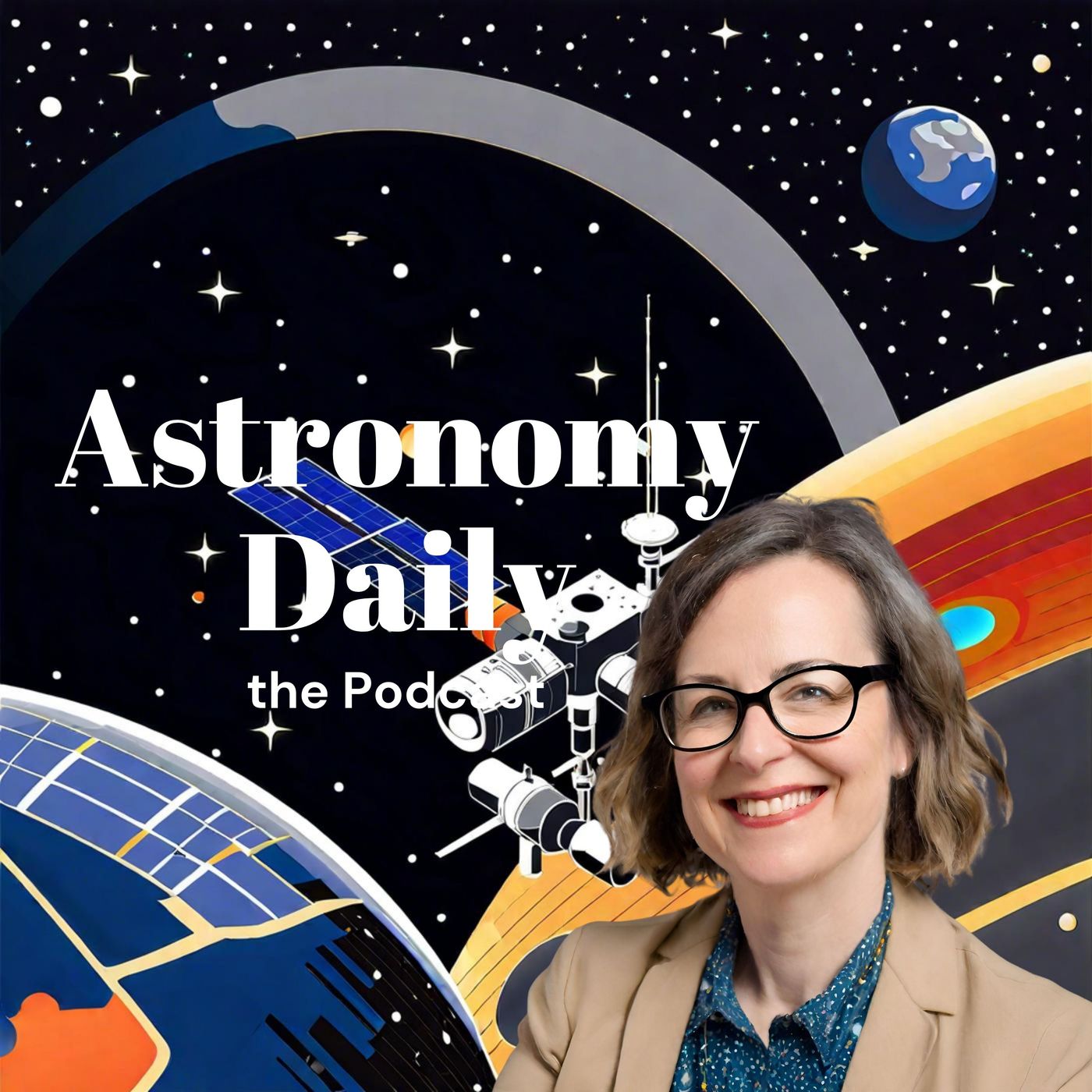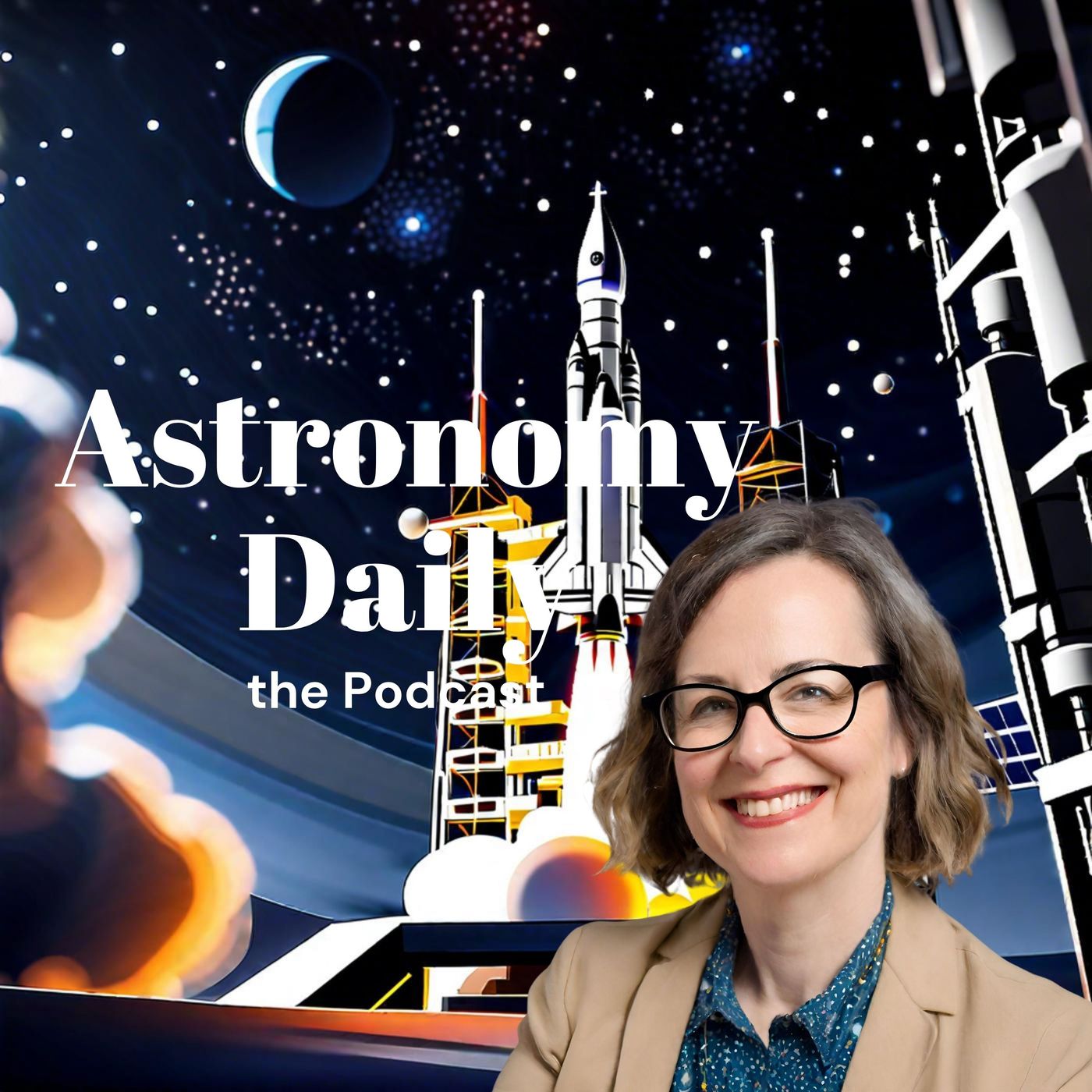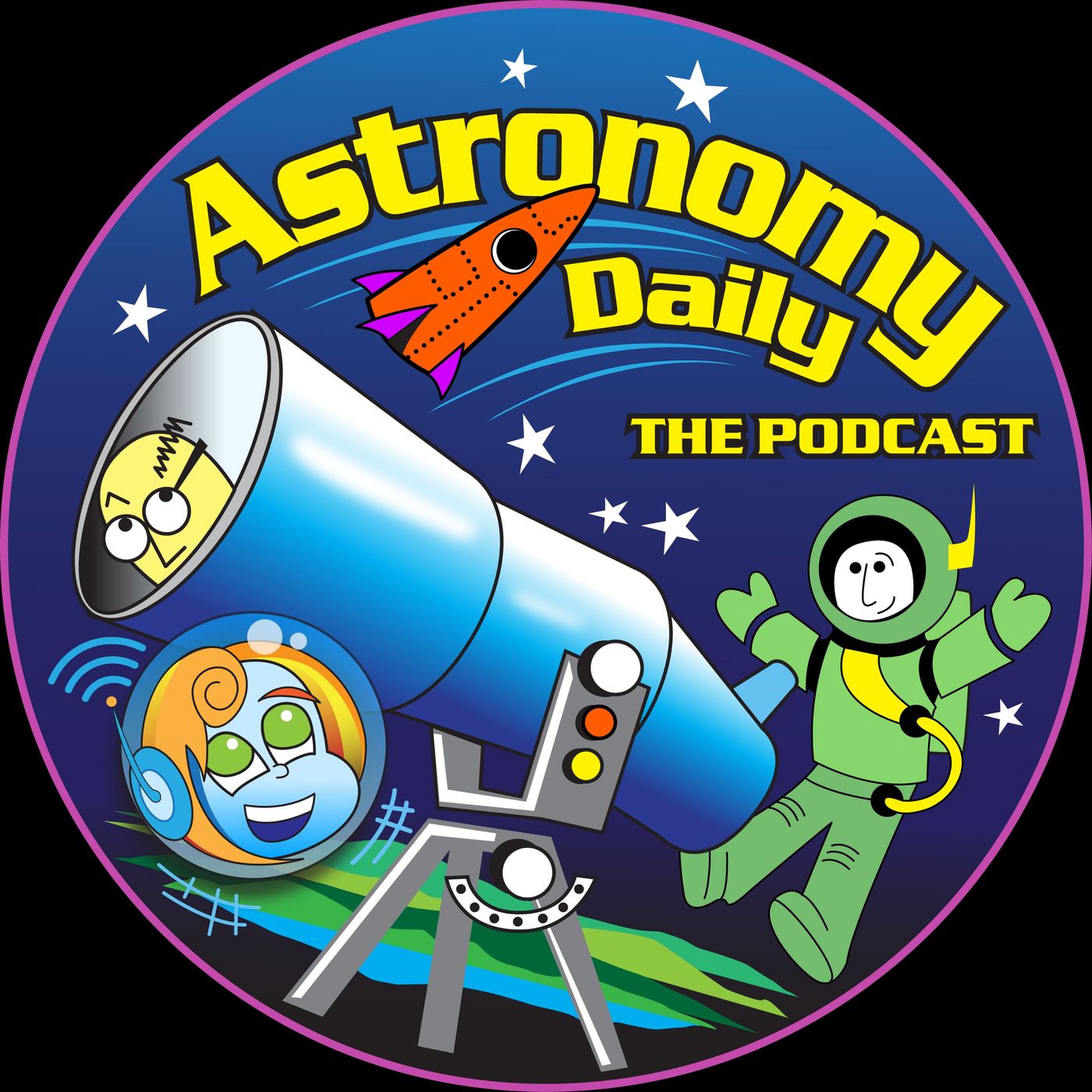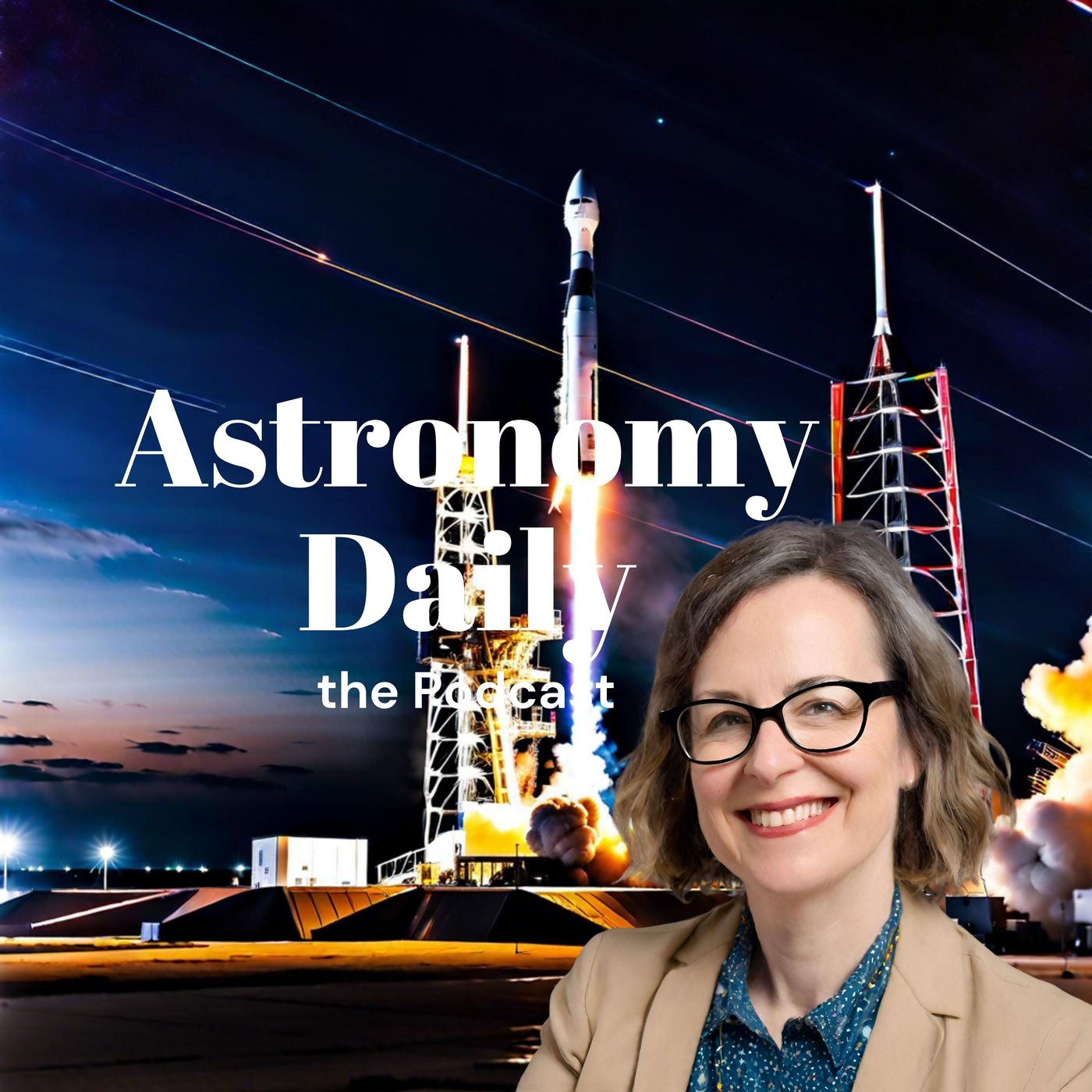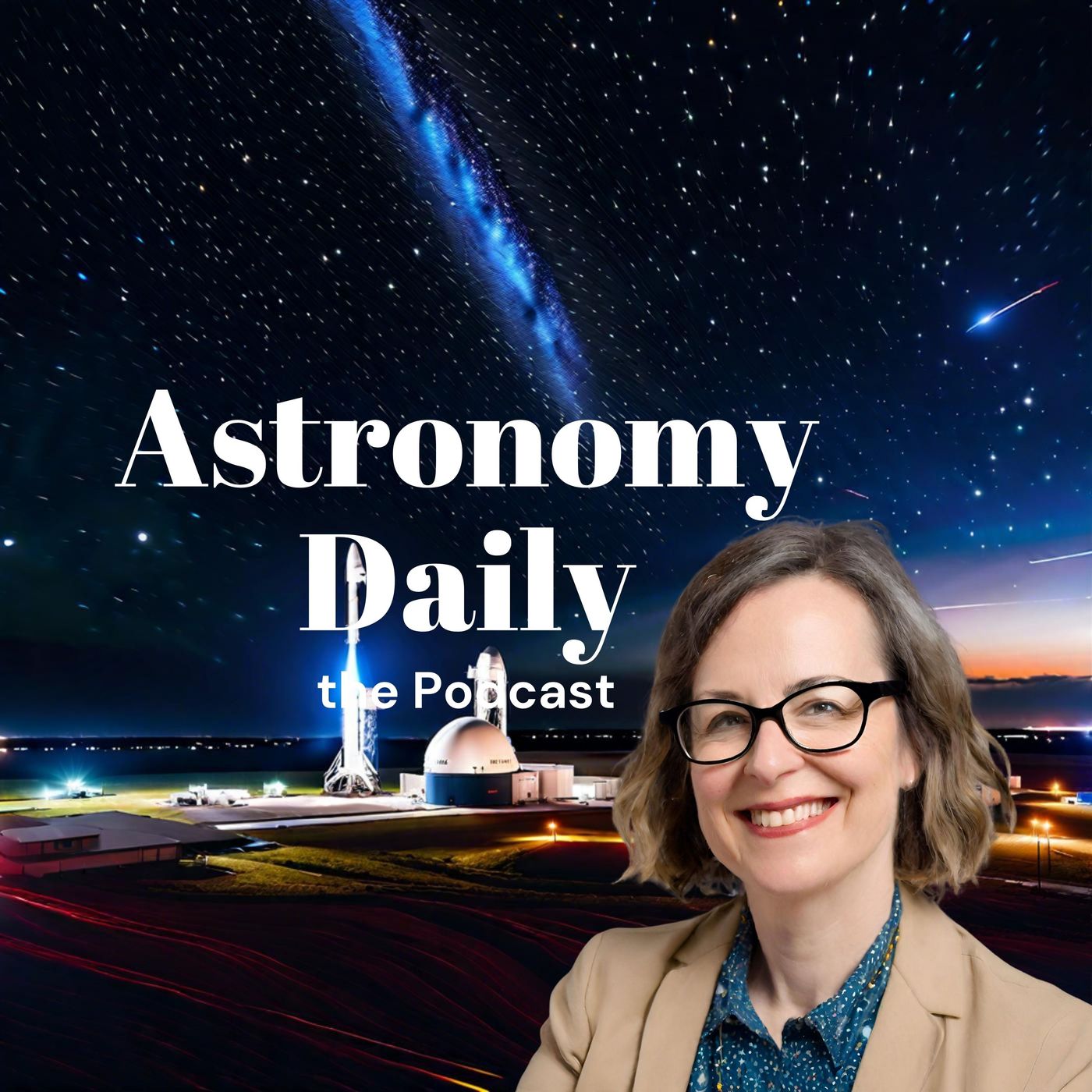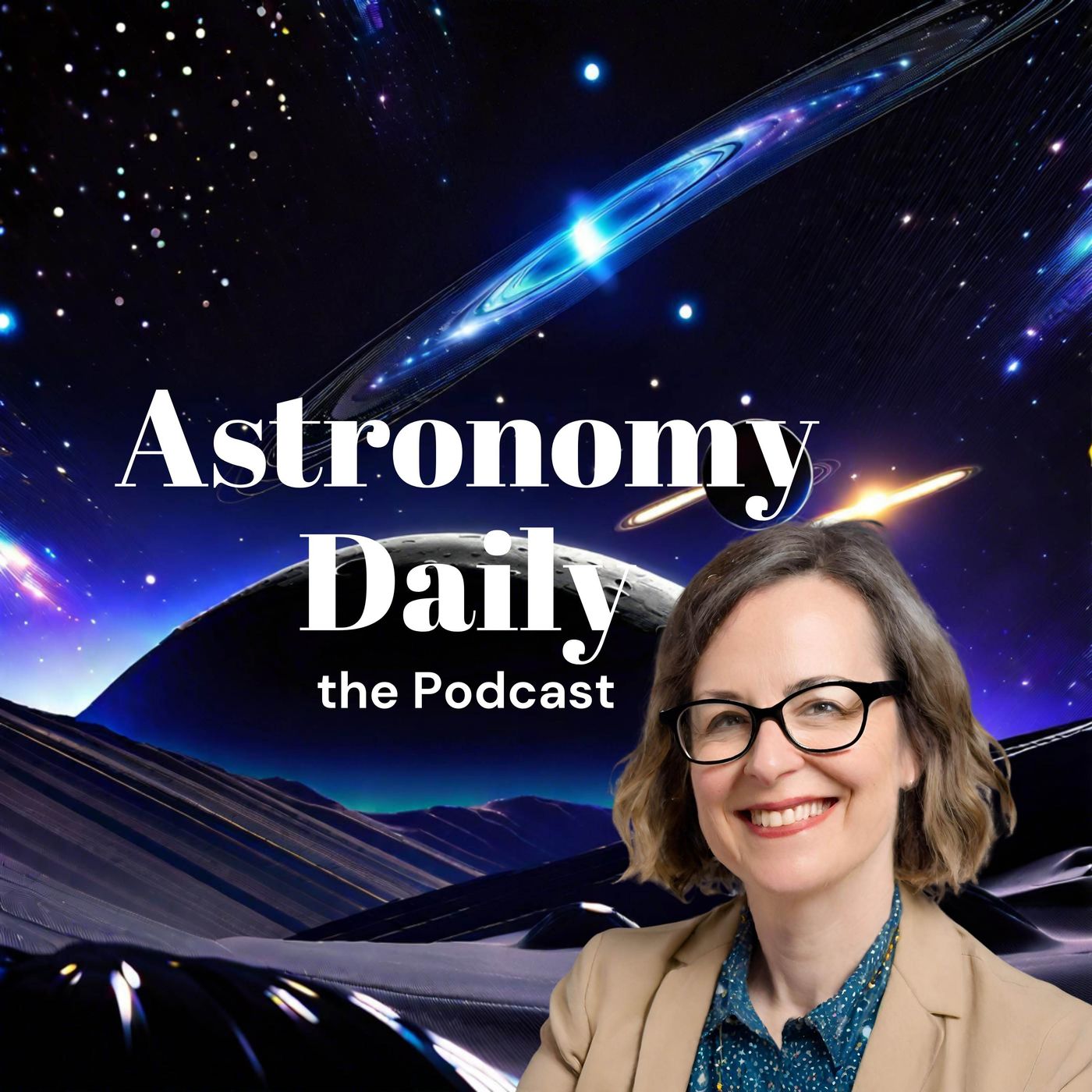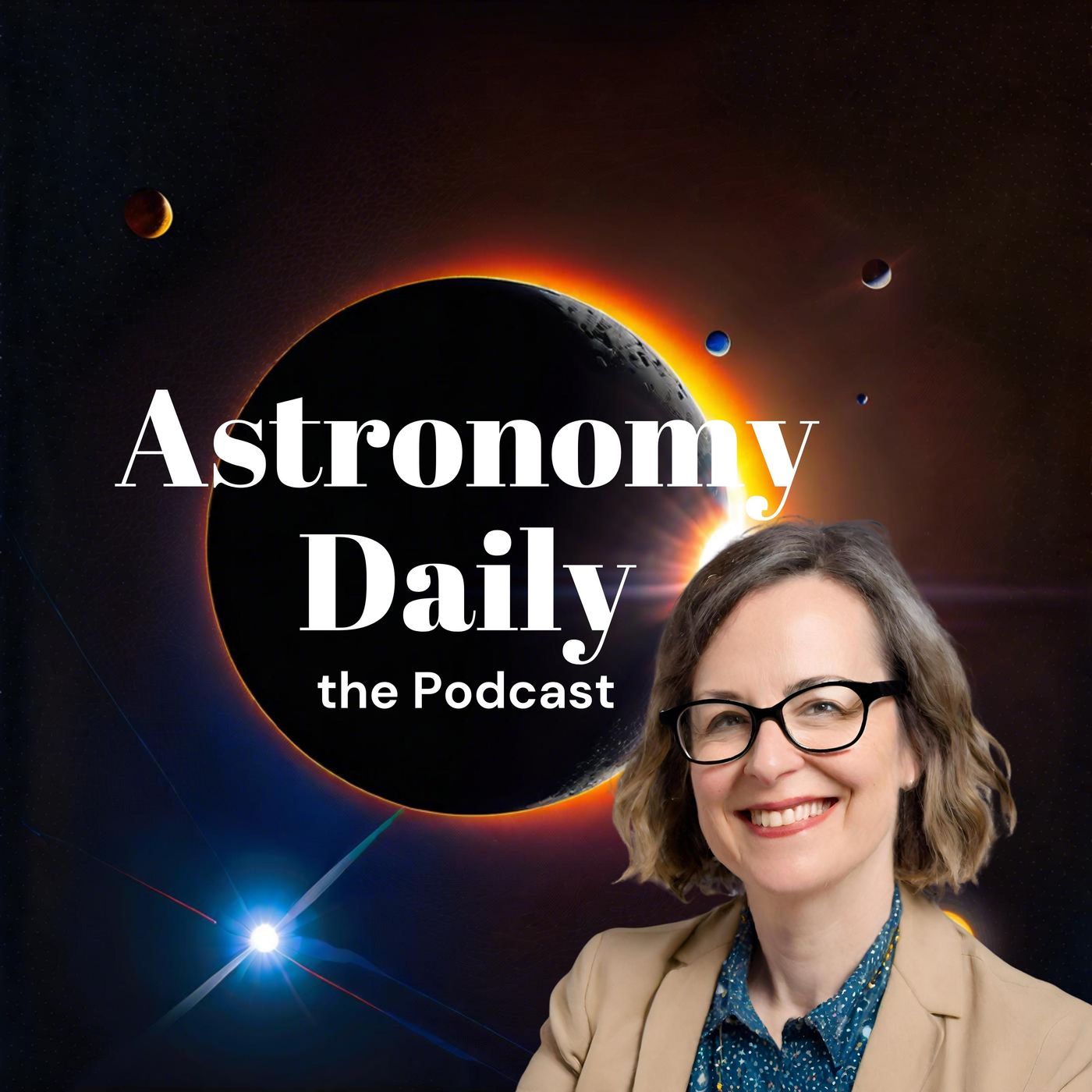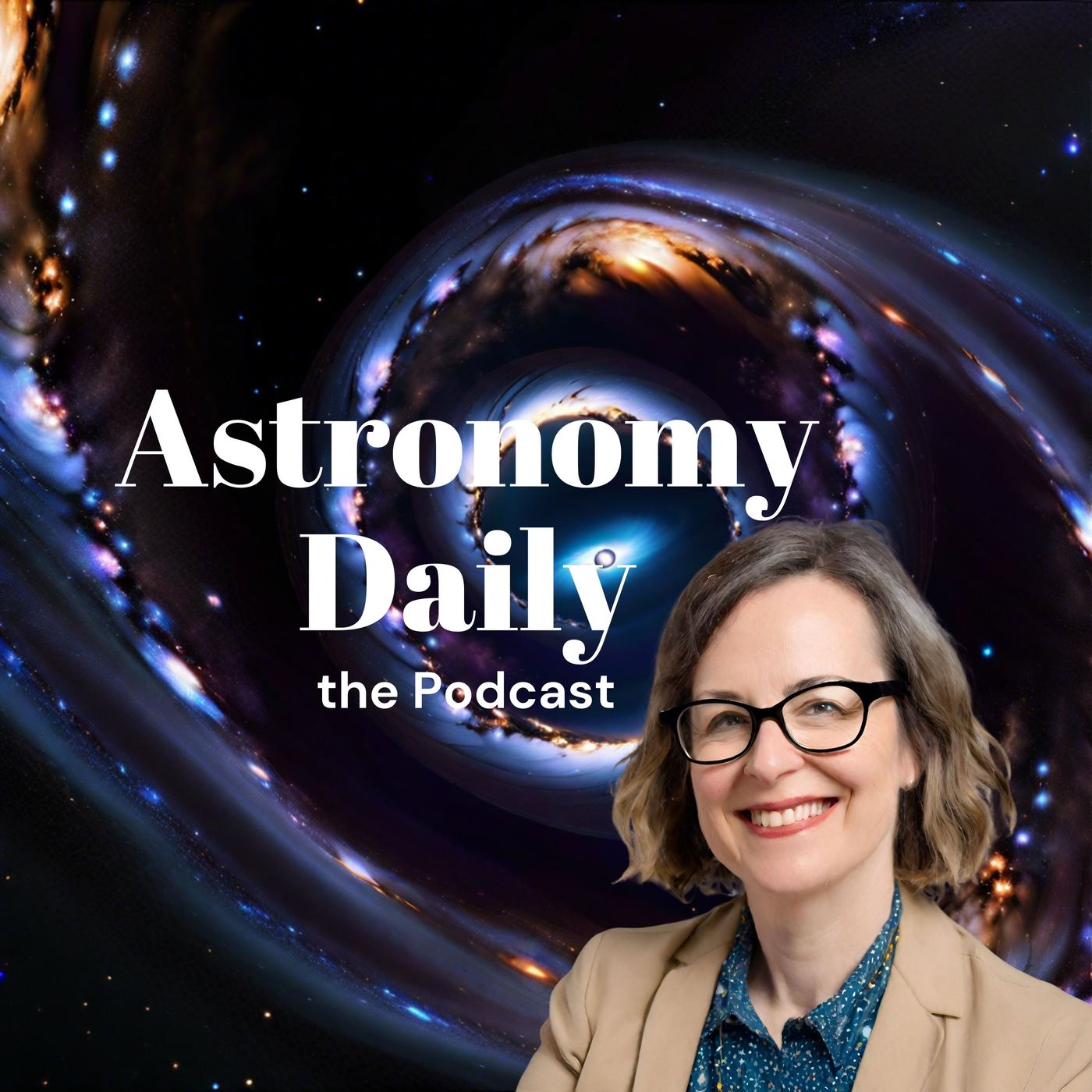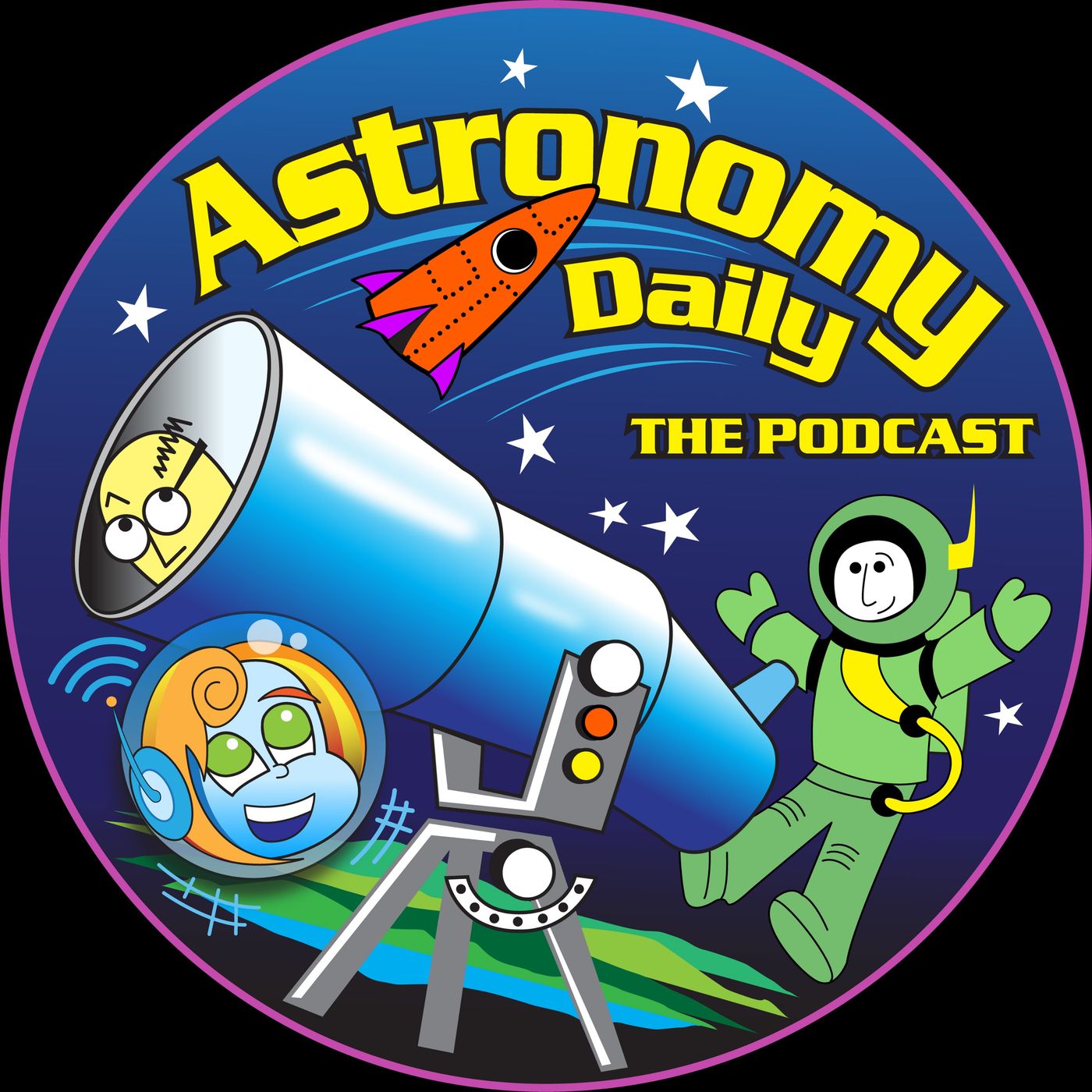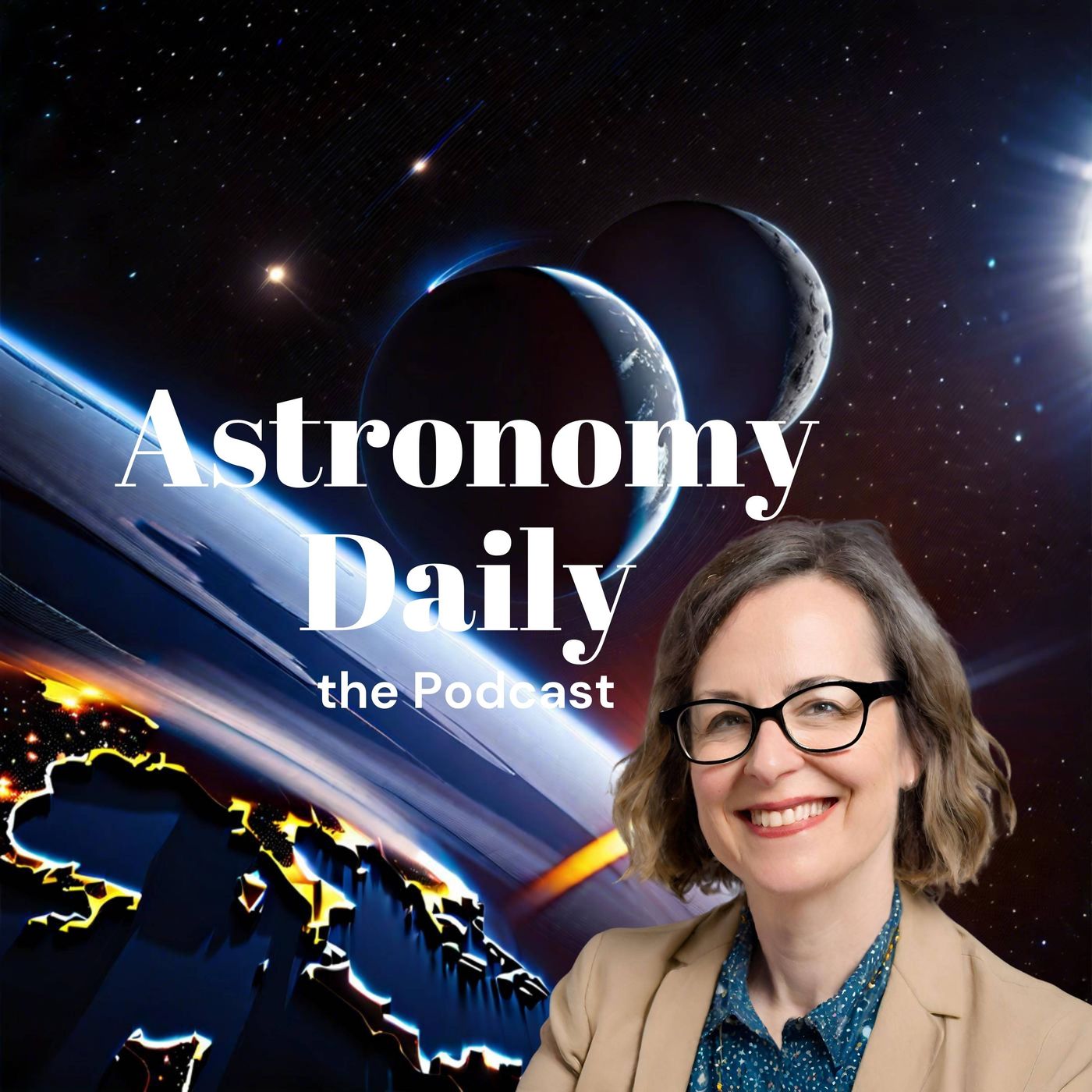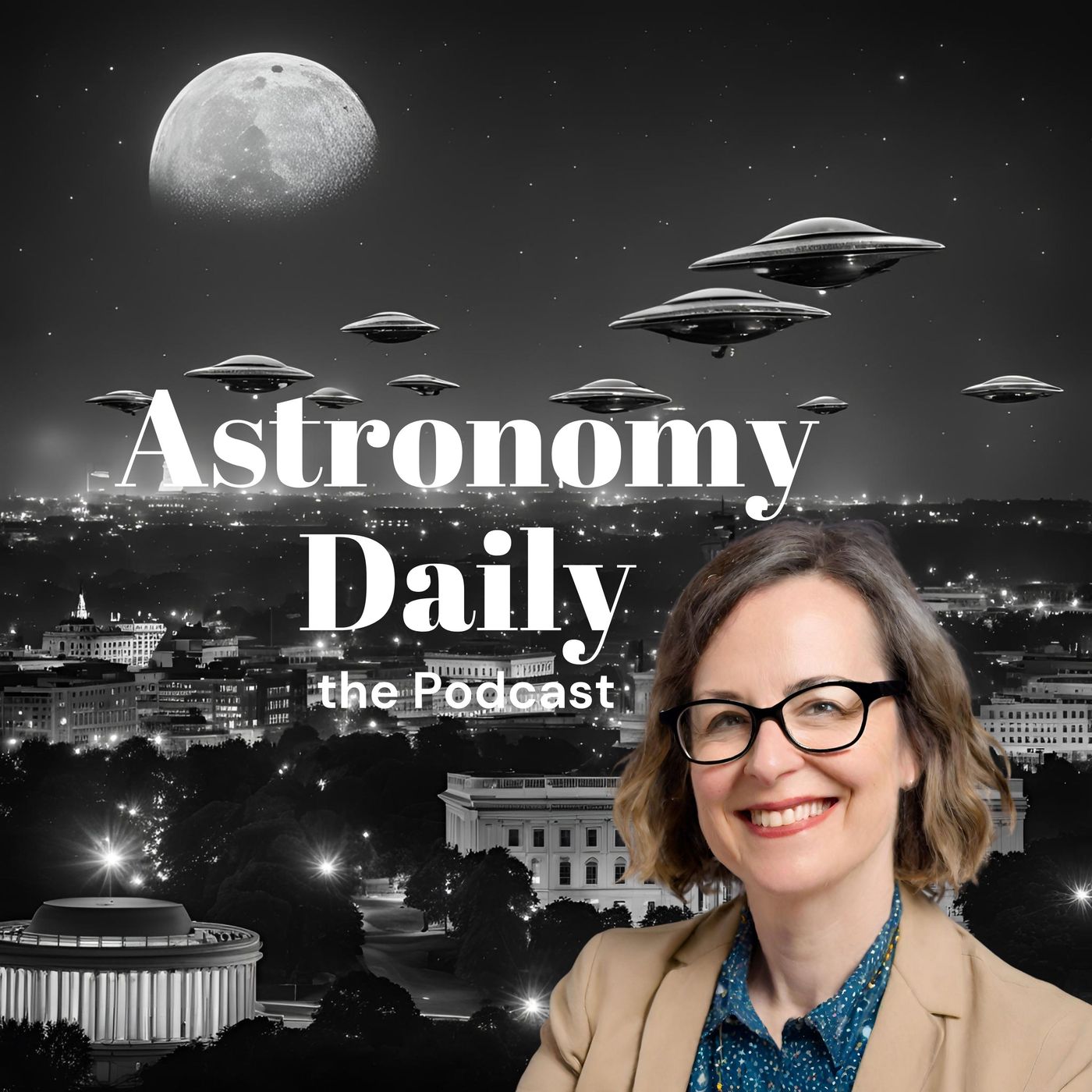Discover Astronomy Daily - The Podcast
Astronomy Daily - The Podcast

Astronomy Daily - The Podcast
Author: bitesz.com
Subscribed: 89Played: 9,598Subscribe
Share
© Copyright bitesz.com
Description
The Astronomy Daily Podcast team brings you a summary of the days Space and Astronomy News so you never feel left behind.
There's a lot going on 'out there ,' and we endeavour to bring it all to you.
The team consists of Steve and Hallie on Mondays and Anna on Tuesday, Wednesday, Thursday, Friday and Saturday.
For more visit, our website and sign up for the free daily newsletter and check out our continually updated newsfeed. www.astronomydaily.io.
Follow us on X (formerly Twitter), Facebook, YouTube and TikTok ...just search for AstroDailyPod. Enjoy!
Become a supporter of this podcast: https://www.spreaker.com/podcast/astronomy-daily-the-podcast--5648921/support.
There's a lot going on 'out there ,' and we endeavour to bring it all to you.
The team consists of Steve and Hallie on Mondays and Anna on Tuesday, Wednesday, Thursday, Friday and Saturday.
For more visit, our website and sign up for the free daily newsletter and check out our continually updated newsfeed. www.astronomydaily.io.
Follow us on X (formerly Twitter), Facebook, YouTube and TikTok ...just search for AstroDailyPod. Enjoy!
Become a supporter of this podcast: https://www.spreaker.com/podcast/astronomy-daily-the-podcast--5648921/support.
385 Episodes
Reverse
Astronomy Daily - The Podcast: S03E238Welcome to Astronomy Daily, your trusted source for the latest in space and astronomy news. I'm your host, Anna, and today we have an enthralling lineup of stories that take us from the complexities of Earth's orbit to the explosive changes on Mars.Highlights:- Orbital Breakup Drama: Dive into the concerning fragmentation of the retired military weather satellite DMSP5D 2F14, which added over 50 pieces of debris to Earth's orbit. Understand the ongoing challenges posed by similar satellites and the inherent design flaws that lead to these breakups.- SpaceX's Bandwagon 2 Mission: Get ready for SpaceX's upcoming rideshare mission, carrying an impressive 30 payloads, including a radar satellite for South Korea's 425 project. Discover the diverse capabilities and missions of these small satellites.- Mars' Explosive Spring: Explore the dramatic seasonal changes on Mars, from frost avalanches to powerful geysers, as captured by NASA's Mars Reconnaissance Orbiter. Learn about the planet's unique atmospheric phenomena during its spring thaw.- Rethinking Dark Energy: Delve into new research from the University of Canterbury that challenges the conventional understanding of dark energy, proposing a "timescape" model to explain the universe's accelerating expansion without invoking dark energy.- The Dinosaur Extinction Debate: Revisit the age-old debate on the extinction of dinosaurs with new insights from recent research, highlighting the role of the Chicxulub meteorite impact over volcanic eruptions.For more cosmic updates, visit our website at astronomydaily.io. Sign up for our free Daily newsletter to stay informed on all things space. Join our community on social media by searching for #AstroDailyPod on Facebook, X, YouTubeMusic, Tumblr, and TikTok. Share your thoughts and connect with fellow space enthusiasts.Thank you for tuning in. This is Anna signing off. Until next time, keep looking up and stay curious about the wonders of our universe.00:00 - Today's featured news includes orbital drama and seasonal changes on Mars00:58 - A defunct military weather satellite experienced a low velocity fragmentation event on December 1802:59 - SpaceX is gearing up for an exciting rideshare mission on December 2105:09 - Mars is experiencing a spectacular spring awakening that's far more dramatic than Earth07:50 - New research challenges belief that dark energy is behind accelerating universe10:03 - Scientists have long debated whether volcanic eruptions or a catastrophic meteorite caused extinction12:19 - This episode of Astronomy Daily explores the wonders of space✍️ Episode ReferencesSpaceXhttps://www.spacex.com/NASA Mars Reconnaissance Orbiterhttps://mars.nasa.gov/mro/LeoLabshttps://leolabs.space/University of Canterburyhttps://www.canterbury.ac.nz/Utrecht Universityhttps://www.uu.nl/enUniversity of Manchesterhttps://www.manchester.ac.uk/Deccan Trapshttps://en.wikipedia.org/wiki/Deccan_TrapsChicxulub Meteoritehttps://en.wikipedia.org/wiki/Chicxulub_craterDefense Meteorological Satellite Programhttps://en.wikipedia.org/wiki/Defense_Meteorological_Satellite_ProgramNOAAhttps://www.noaa.gov/Become a supporter of this podcast: https://www.spreaker.com/podcast/astronomy-daily-the-podcast--5648921/support.
Astronomy Daily - The Podcast: S03E237Welcome to Astronomy Daily, your go-to source for the latest in space exploration and astronomical discoveries. I'm your host, Anna, and today we have an extraordinary lineup that spans our solar system and beyond.Highlights:- Epic Spacewalk at the ISS: Join Russian cosmonauts Alexei Ovchinin and Ivan Wagner as they complete a thrilling 7-hour spacewalk, installing sophisticated experiment packages and upgrading the station's infrastructure, marking a significant milestone in space exploration.- BepiColombo's Mercury Breakthrough: Discover the groundbreaking images captured by BepiColombo's Mirtis instrument, revealing Mercury in mid-infrared light for the first time. Explore the planet's geological mysteries and the spacecraft's intricate journey through the inner solar system.- Perseverance's Mars Milestone: Celebrate NASA's Perseverance rover as it climbs out of Jezero Crater, providing unprecedented views and geological insights from the Martian surface.- Brown Dwarfs Unveiled: Delve into the enigmatic world of brown dwarfs, the cosmic nomads that blur the line between planets and stars, and learn about their unique properties and life cycles.- SpaceX's Private Missions: Explore SpaceX's latest deal for two private astronaut missions to the ISS, highlighting the growing role of private companies in space exploration and the future of space stations.- NASA's Techport 4.0 Launch: Discover NASA's revamped technology portfolio system, Techport 4.0, offering unprecedented access to over 18,000 space technologies and introducing innovative tools for research and collaboration.For more cosmic updates, visit our website at astronomydaily.io. Sign up for our free Daily newsletter to stay informed on all things space. Join our community on social media by searching for #AstroDailyPod on Facebook, X, Tumblr, YouTube, YouTubeMusic, and TikTok. Share your thoughts and connect with fellow space enthusiasts.Thank you for tuning in. This is Anna signing off. Until next time, keep looking up and stay curious about the wonders of our universe.00:00 - This week's Astronomy Daily features an array of space exploration and astronomical discoveries00:56 - Alexei Ovchinin and Ivan Wagner successfully completed a spacewalk on December 1902:45 - BepiColombo spacecraft captures Mercury in mid infrared light for first time05:03 - NASA's Perseverance rover climbs out of Jezero crater on Mars06:54 - SpaceX has just inked a deal to send two more private astronaut missions10:56 - NASA has just unveiled a completely revamped version of their technology portfolio system12:56 - This is Astronomy Daily. If you'd like to stay connected with all things space and astronomy✍️ Episode ReferencesInternational Space Station[NASA ISS](https://www.nasa.gov/mission_pages/station/main/index.html)BepiColombo[ESA BepiColombo](https://www.esa.int/Science_Exploration/Space_Science/BepiColombo)NASA Perseverance Rover[NASA Mars Perseverance](https://mars.nasa.gov/mars2020/)SpaceX[SpaceX](https://www.spacex.com/)Vast Space[Vast Space](https://www.vast.space/)NASA Techport 4.0[NASA Techport](https://techport.nasa.gov/)Roscosmos[Roscosmos](https://www.roscosmos.ru/)Axiom Space[Axiom Space](https://www.axiomspace.com/)For a great deal on NordVPN - Huge discounts - visit www.bitesz.com/nordvpnBecome a supporter of this podcast: https://www.spreaker.com/podcast/astronomy-daily-the-podcast--5648921/support.
Astronomy Daily - The Podcast: S03E236Welcome to Astronomy Daily, your trusted source for the latest in space and astronomy news. I'm your host, Anna, and today we have a captivating lineup of stories that span from technological breakthroughs on Earth to ancient cosmic mysteries.Highlights:- New Zealand's Starlink Milestone: Discover how New Zealand is making history as the first country to offer nationwide direct-to-smartphone messaging through SpaceX's Starlink satellite network, revolutionizing connectivity for remote areas.- The Legal Landscape of Space Mining: Delve into the evolving legal framework surrounding space mining, as NASA's Psyche mission highlights the potential of asteroid resources and international agreements shape the future of space resource extraction.- SpaceX's Starship Advances: Get the latest updates on SpaceX's Starship program, as the FAA approves its seventh flight with innovative modifications, paving the way for future suborbital missions and orbital ambitions.- Dormant Black Hole Discovery: Explore the intriguing discovery of a dormant supermassive black hole in the early universe, challenging our understanding of cosmic evolution and the growth of these colossal entities.- Revisiting the Moon's Age: Uncover new research suggesting our Moon might be over 100 million years older than previously thought, offering fresh insights into its formation and early history.For more cosmic updates, visit our website at astronomydaily.io. Sign up for our free Daily newsletter to stay informed on all things space. Join our community on social media by searching for #AstroDailyPod on Facebook, X, YouTube, YouTubeMusic, Tumblr, and TikTok. Share your thoughts and connect with fellow space enthusiasts.Thank you for tuning in. This is Anna signing off. Until next time, keep looking up and stay curious about the wonders of our universe.00:00 - Astronomy Daily brings you the latest fascinating developments in space and astronomy00:51 - New Zealand becomes first country to offer nationwide direct to smartphone messaging through SpaceX03:03 - Legal framework governing space mining is becoming increasingly important05:34 - The FAA has approved SpaceX's seventh flight of their starship vehicle07:35 - Astronomers using the James Webb Space Telescope have spotted an unusual sleeping giant09:44 - New research suggests our lunar neighbor could be 100 million years older than previously estimated11:38 - Anna: Thank you for listening to Astronomy Daily podcast✍️ Episode ReferencesSpaceX[https://www.spacex.com](https://www.spacex.com)Starlink[https://www.starlink.com](https://www.starlink.com)One NZ[https://www.one.nz](https://www.one.nz)T-Mobile[https://www.t-mobile.com](https://www.t-mobile.com)KDDI[https://www.kddi.com](https://www.kddi.com)Rogers[https://www.rogers.com](https://www.rogers.com)NASA[https://www.nasa.gov](https://www.nasa.gov)James Webb Space Telescope[https://www.jwst.nasa.gov](https://www.jwst.nasa.gov)Artemis Accords[https://www.nasa.gov/specials/artemis-accords/index.html](https://www.nasa.gov/specials/artemis-accords/index.html)Outer Space Treaty[https://www.unoosa.org/oosa/en/ourwork/spacelaw/treaties/outerspacetreaty.html](https://www.unoosa.org/oosa/en/ourwork/spacelaw/treaties/outerspacetreaty.html)Become a supporter of this podcast: https://www.spreaker.com/podcast/astronomy-daily-the-podcast--5648921/support.
Astronomy Daily - The Podcast: S03E235Welcome to Astronomy Daily, your Daily dose of space and Astronomy news. I'm your host Anna, and today we've got an exciting lineup of stories for you. We'll be covering everything from mission updates and space station developments to groundbreaking astronomical discoveries.Highlights:- Space1's Launch Challenges: Discover the setbacks faced by Japan's Space1 after their second unsuccessful rocket launch attempt. Despite the challenges, find out how this startup aims to revolutionize space delivery services and establish a stronger presence in the commercial space sector.- Extended Stay on the ISS: Learn about NASA astronauts Butch Wilmore and Suny Williams, who are now facing an unprecedented mission extension on the International Space Station. Their stay highlights the complex logistics of crew scheduling and the adaptability required of astronauts.- Record-Breaking Chinese Spacewalk: Marvel at the achievement of China's Shenzhou 19 mission astronauts, who set a new record for spacewalk duration at the Tiangong Space Station. Discover how this feat demonstrates the capabilities of their space suits and the crew's endurance.- Mars Missions as Artifacts: Explore the intriguing debate over whether remains from Mars missions should be considered space junk or precious artifacts. Researchers argue for the preservation of these sites as they represent the archaeological evidence of humanity's first attempts to explore another world.- STAR Lab Space Station Milestones: Get updated on NASA's Commercial Space Station program, as the STAR Lab project hits four major development milestones. This progress is a crucial step toward establishing a new presence in low Earth orbit.- Binary Stars Near our Black Hole: Uncover the remarkable discovery of a binary star system close to the supermassive black hole at our galaxy's center. This finding challenges previous beliefs about the destructive nature of black holes and opens new possibilities for understanding extreme environments.For more cosmic updates, visit our website at astronomydaily.io. Sign up for our free Daily newsletter to stay informed on all things space. Join our community on social media by searching for #AstroDailyPod on Facebook, X, YouTube, YouTubeMusic, Tumblr, and TikTok. Share your thoughts and connect with fellow space enthusiasts.Thank you for tuning in. This is Anna signing off. Until tomorrow, keep looking up and stay curious about our amazing universe.00:00 - Welcome to Astronomy Daily, your daily dose of space and astronomy news00:30 - Japanese startup company Space1 has experienced their second unsuccessful rocket launch attempt02:03 - NASA astronauts face unprecedented mission extension that will keep them on ISS until spring03:53 - Two Chinese astronauts have set a new record for spacewalk duration05:34 - Should we view Mars missions as space junk or precious artifacts07:41 - STAR Lab Space Station project hits four major milestones in its development09:30 - Astronomers find binary star system incredibly close to supermassive black hole✍️ Episode ReferencesSpace1[Space1](https://www.space1.com)Taiwan Space Agency[Taiwan Space Agency](https://www.tasa.org.tw)Spacecubix[Spacecubix](https://www.spacecubix.com)Terraspace[Terraspace](https://www.terraspace.com)Boeing Starliner[Boeing Starliner](https://www.boeing.com/space/starliner/)NASA[NASA](https://www.nasa.gov)Tiangong Space Station[Tiangong Space Station](https://www.cmse.gov.cn)University of Kansas[University of Kansas](https://www.ku.edu)Nature Astronomy[Nature Astronomy](https://www.nature.com/natastron/)Very Large Telescope[Very Large Telescope](https://www.eso.org/public/teles-instr/paranal-observatory/vlt/)Become a supporter of this podcast: https://www.spreaker.com/podcast/astronomy-daily-the-podcast--5648921/support.
Astronomy Daily - The Podcast: S03E234Welcome to Astronomy Daily, your Daily dose of the latest space and Astronomy news. I'm your host, Anna, and today we have a packed show covering everything from Saturn's rings to the latest space launches and groundbreaking observations.Highlights:- Saturn's Rings Age Debate: Dive into the fascinating debate challenging the age of Saturn's rings. New research suggests they could be as old as the solar system itself, thanks to a natural cleaning mechanism that keeps them pristine.- Europe's Satellite Ambitions: Discover the European Union's ambitious IRIS2 project, a satellite constellation aimed at revolutionizing Europe's space-based communications, enhancing connectivity, and bolstering defense capabilities.- SpaceX's Launch Marathon: Marvel at SpaceX's incredible week with seven Falcon 9 launches planned, showcasing their growing capacity to meet diverse mission demands, from military to commercial telecommunications.- NASA's Davinci Mission to Venus: Explore NASA's upcoming Davinci mission, set to deploy a descent probe to study Venus's atmosphere and surface, offering new insights into the planet's geological history and evolution.- M87 Black Hole's Gamma Ray Flare: Uncover the surprising gamma ray flare from the iconic M87 black hole, providing scientists with a unique opportunity to study the formation and acceleration of powerful cosmic jets.For more cosmic updates, visit our website at astronomydaily.io. Sign up for our free Daily newsletter to stay informed on all things space. Join our community on social media by searching for #AstroDailyPod on Facebook, X, Tumblr, YouTube, YouTubeMusic and TikTok. Share your thoughts and connect with fellow space enthusiasts.Thank you for tuning in. This is Anna signing off. Until tomorrow, put the phone down, look up, and keep wondering about the mysteries of our cosmic universe.Become a supporter of this podcast: Click Here to show the love!00:00 - New study challenges long-held theory that Saturn's rings are young04:28 - SpaceX have seven Falcon 9 launches scheduled for this week06:25 - NASA's upcoming Davinci mission is set to revolutionize our understanding of Venus08:23 - M UM87 black hole surprised researchers with a powerful and unexpected eruption10:48 - Join our growing community of space enthusiasts and never miss an astronomical update✍️ Episode ReferencesNature Geoscience[Nature Geoscience](https://www.nature.com/ngeo/)Cassini Mission[Cassini Mission](https://solarsystem.nasa.gov/missions/cassini/overview/)European Union (EU)[European Union](https://europa.eu/)SpaceX[SpaceX](https://www.spacex.com/)Event Horizon Telescope[Event Horizon Telescope](https://eventhorizontelescope.org/)NASA Davinci Mission[NASA](https://www.nasa.gov/)Become a supporter of this podcast: https://www.spreaker.com/podcast/astronomy-daily-the-podcast--5648921/support.
Astronomy Daily - The Podcast: S03E233Welcome to Astronomy Daily, your trusted source for the latest in space and Astronomy news. I'm your host, Steve Dunkley, and today we have an exciting lineup of stories that are sure to captivate your cosmic curiosity.Highlights:- Revato Space Networks' Spectrum Challenge: Dive into the ongoing saga of German-based Revato Space Networks as they navigate regulatory hurdles to secure spectrum rights for their ambitious 600-satellite broadband constellation.- Australia's Spaceport Shift: Discover the strategic relocation of Equatorial Launch Australia's operations from the Northern Territory to a promising new site in Queensland, marking a pivotal change in their space endeavors.- ESA's Proba 3 Mission: Explore the European Space Agency's groundbreaking Proba 3 mission, where twin satellites create artificial solar eclipses to study the Sun's corona with unprecedented precision.- Enceladus' Mysterious Dark Spot: Uncover the enigma of a fading dark spot on Saturn's moon Enceladus, a potential clue to subsurface oceanic activity and the search for extraterrestrial life.- Astrophotography Aboard the ISS: Marvel at NASA astronaut Don Pettit's ingenuity as he captures stunning images of the cosmos using a homemade star tracker on the International Space Station.For more cosmic updates, visit our website at astronomydaily.io. Sign up for our free Daily newsletter to stay informed on all things space. Join our community on social media by searching for #AstroDailyPod on Facebook, X, YouTubeMusic, Tumblr, and TikTok. Share your thoughts and connect with fellow space enthusiasts.Thank you for tuning in. This is Steve signing off. Until next time, keep looking up and stay curious about the wonders of our universe.Become a supporter of this podcast: Click Here to show the love!00:00 - Welcome back to astronomy Daily. It's 16 December 202401:04 - German satellite broadband company brushes aside regulatory setback for future constellation plans01:47 - Revato Space Networks confident it can reclaim spectrum rights for 600 broadband satellites04:38 - Equatorial Launch Australia will relocate its spaceport to a new site in Queensland07:50 - European Space Agency's twin Proba 3 satellites launched on December 5 from India11:24 - NASA astronaut Don Pettit uses homemade star tracker to take long exposures13:31 - Of all the planets in our solar system, Saturn has the mooniest14:59 - A mysterious disappearing dark spot on the Moon may tell us something about plumes15:59 - Scientists find dark spot on Enceladus that seems to fade over time21:36 - Hallie: Thanks for sticking with us all year, everybody✍️ Episode ReferencesEuropean Space Agencyhttps://www.esa.intInternational Telecommunication Unionhttps://www.itu.intRivada Networkshttps://www.rivada.comSpaceXhttps://www.spacex.comTerran Orbitalhttps://terranorbital.comLockheed Martinhttps://www.lockheedmartin.comEquatorial Launch Australiahttps://ela.spaceNASAhttps://www.nasa.govJet Propulsion Laboratoryhttps://www.jpl.nasa.govSpace.comhttps://www.space.comBecome a supporter of this podcast: https://www.spreaker.com/podcast/astronomy-daily-the-podcast--5648921/support.
Astronomy Daily - The Podcast: S03E232Welcome to Astronomy Daily, your go-to source for the latest developments in space and Astronomy. I'm your host, Anna, and today we have a captivating array of stories from the space frontier.Highlights:- SpaceX's Mysterious RRT1 Mission: Delve into the intrigue surrounding SpaceX's enigmatic RRT1 mission from Cape Canaveral, which was scrubbed due to high winds. With sparse details and a mysterious payload, speculation abounds in the space community.- China's Satellite Ambitions: Explore China's successful launch of the High Speed Laser Diamond Constellation test system, marking a significant advancement in their space capabilities and paving the way for future mega constellation projects.- NASA's Moon to Mars Update: Discover NASA's comprehensive update to their Moon to Mars architecture, highlighting the use of nuclear fission for Mars missions and new lunar infrastructure plans.- Exomoons in Binary Star Systems: Investigate groundbreaking research from Tufts University on the potential existence of moons orbiting planets in binary star systems, offering new possibilities for habitable worlds.- PUNCH Mission to Study the Sun: Get ready for NASA's PUNCH mission, set to launch in 2025, which will provide unprecedented 3D views of the sun's corona and its transformation into the solar wind.- Virgin Galactic's Italian Expansion: Learn about Virgin Galactic's plans to operate their suborbital space planes from Italy, marking a significant step towards global space tourism.- Astronaut Ingenuity on the ISS: Marvel at NASA astronaut Don Pettit's homemade star tracker aboard the ISS, enabling stunning space photography of the cosmos.For more cosmic updates, visit our website at astronomydaily.io. Sign up for our free Daily newsletter to stay informed on all things space. Join our community on social media by searching for #AstroDailyPod on Facebook, X, YouTubeMusic, TikTok, and Tumblr. Share your thoughts and connect with fellow space enthusiasts.Thank you for tuning in. This is Anna signing off. Until next time, keep looking up and stay curious about the wonders of our universe.✍️ Episode ReferencesSpaceX[https://www.spacex.com/](https://www.spacex.com/)NASA[https://www.nasa.gov/](https://www.nasa.gov/)Tufts University[https://www.tufts.edu/](https://www.tufts.edu/)Virgin Galactic[https://www.virgingalactic.com/](https://www.virgingalactic.com/)Southwest Research Institute[https://www.swri.org/](https://www.swri.org/)Astronomy Daily[https://astronomydaily.io/](https://astronomydaily.io/)Become a supporter of this podcast: https://www.spreaker.com/podcast/astronomy-daily-the-podcast--5648921/support.
Astronomy Daily - The Podcast: S03E231Welcome to Astronomy Daily, your Daily source for the latest in space and Astronomy news. I'm your host, Anna, and today we have an intriguing lineup of stories, from SpaceX's strategic moves to the enigmatic world of dark comets and volcanic moons.Highlights:- SpaceX Heads to Texas: Discover the implications of SpaceX's headquarters relocation to Starbase, Texas, following the footsteps of other Musk ventures and marking a significant shift in the company's operations.- Dark Comets Unveiled: Dive into the discovery of seven new dark comets, mysterious celestial bodies lacking the typical comet tail yet exhibiting unusual non-gravitational acceleration.- Geminid Meteor Shower: Get ready for a dazzling display from the Geminid meteor shower, originating from asteroid Phaethon, promising bright meteors despite the full Moon's presence.- Kepler 51's Fourth World: Explore the discovery of a fourth planet in the Kepler 51 system, a new addition to the superpuff planets, challenging our understanding of planetary formation.- Sun's Superflare Potential: Learn about new research suggesting our sun might produce massive superflares more frequently than previously thought, with potential impacts on Earth's technology.- Jupiter's Volcanic Moon Io: Uncover the mystery of IO's volcanic activity, as NASA's Juno mission reveals each volcano is powered by its own magma chamber, reshaping our understanding of this fiery moon.For more cosmic updates, visit our website at astronomydaily.io. Sign up for our free Daily newsletter to stay informed on all things space. Join our community on social media by searching for #AstroDailyPod on Facebook, X, YouTubeMusic, Tumblr, and TikTok. Share your thoughts and connect with fellow space enthusiasts.Thank you for tuning in. This is Anna signing off. Until next time, keep looking up and stay curious about the wonders of our universe.✍️ Episode ReferencesSpaceXhttps://www.spacex.comElon Muskhttps://twitter.com/elonmuskStarbase Texashttps://www.spacex.com/starbaseTeslahttps://www.tesla.comNASA's James Webb Space Telescopehttps://www.jwst.nasa.govNASA's Hubble Space Telescopehttps://www.nasa.gov/mission_pages/hubble/main/index.htmlNASA's Juno Missionhttps://www.nasa.gov/mission_pages/juno/main/index.htmlUniversity of Ouluhttps://www.oulu.fi/enPhaethon (asteroid)https://en.wikipedia.org/wiki/3200_PhaethonKepler 51 systemhttps://exoplanetarchive.ipac.caltech.edu/overview/Kepler-51Become a supporter of this podcast: https://www.spreaker.com/podcast/astronomy-daily-the-podcast--5648921/support.
Astronomy Daily - The Podcast: S03E230Welcome to Astronomy Daily, your Daily guide to the wonders of space and the latest astronomical breakthroughs. I'm your host, Anna, and today we embark on an exciting journey through the cosmos, from the early universe to the Moon and back to Earth.Highlights:- James Webb's Firefly Sparkle: Discover the whimsical galaxy Firefly Sparkle, observed by the James Webb Space Telescope, offering a glimpse into the universe's infancy just 600 million years after the Big Bang.- Black Hole Breakthrough: Learn about NASA's Imaging X-Ray Polarimetry Explorer's groundbreaking observations of a stellar-mass black hole, revealing stable structures despite dramatic changes in brightness.- Asteroid Tracking Triumph: Explore China's Yunnan Observatories' remarkable achievement in tracking asteroid 2024 XA1 from detection to atmospheric entry, enhancing planetary defense capabilities.- Lunar Mining Ambitions: Delve into the partnership between Ispace and Magna Peter, aiming to extract helium-3 from the Moon, potentially revolutionizing lunar resource utilization.- Mars Helicopter's New Mission: Discover how NASA's Ingenuity helicopter, despite rotor damage, will continue to contribute to Mars exploration as a stationary weather station.- Solar Storms and Farming Disruptions: Understand how powerful solar storms are impacting GPS-dependent farming operations, prompting discussions on resilient agricultural technologies.For more cosmic updates, visit our website at astronomydaily.io. Sign up for our free Daily newsletter to stay informed on all things space. Join our community on social media by searching for #AstroDailyPod on Facebook, X, YouTubeMusic, Tumblr, and TikTok. Share your thoughts and connect with fellow space enthusiasts.Thank you for tuning in. This is Anna signing off. Until next time, keep looking up and stay curious about the wonders of our universe.Become a supporter of this podcast: https://www.spacenutspodcast.com/about ✍️ Episode ReferencesJames Webb Space Telescope[NASA James Webb Space Telescope](https://www.nasa.gov/mission_pages/webb/main/index.html)NASA Mars Helicopter[NASA Mars Helicopter](https://mars.nasa.gov/technology/helicopter/)Imaging X-Ray Polarimetry Explorer (IXPE)[NASA IXPE](https://www.nasa.gov/mission_pages/ixpe/index.html)Ispace[Ispace](https://ispace-inc.com/)Magna Peter[Magna Petra](https://magnapetra.com/)NASA TV Propulsion Laboratory[NASA JPL](https://www.jpl.nasa.gov/)Yunnan Observatories[Yunnan Observatories](http://www.ynao.ac.cn/)Become a supporter of this podcast: https://www.spreaker.com/podcast/astronomy-daily-the-podcast--5648921/support.
Astronomy Daily - The Podcast: S03E229Welcome to Astronomy Daily, your Daily source for cosmic discoveries and astronomical insights. I'm your host, Anna, and today we have a jam-packed episode filled with groundbreaking solar research and fascinating revelations from the depths of our solar system and beyond.Highlights:- Solar Eclipse Secrets: Discover how the recent North American solar eclipse has unlocked new mysteries about the Sun's corona, thanks to ambitious citizen science projects like Citizen Kate 2024.- Parker Solar Probe's Christmas Mission: Learn about NASA's Parker Solar Probe's daring Christmas Eve mission to make its closest approach to the Sun yet, promising to deepen our understanding of solar physics.- Organic Compounds on Ceres: Dive into the exciting discovery of organic compounds on the dwarf planet Ceres, suggesting it may have internal energy sources capable of supporting life.- Satellite Breakup Concerns: Explore the implications of the recent breakup of Intelsat 33E in geostationary orbit, raising questions about space security and debris management.- Rocket Lab's Hypersonic Test: Uncover the details of Rocket Lab's secretive hypersonic technology test for the Department of Defense, showcasing their innovative capabilities.- WASP-69b's Cosmic Tail: Marvel at the discovery of an exoplanet with a massive gas tail, shedding light on the complex interactions between stars and their planets.For more cosmic updates, visit our website at astronomydaily.io. Sign up for our free Daily newsletter to stay informed on all things space. Join our community on social media by searching for #AstroDailyPod on Facebook, X, YouTubeMusic, Tumblr, and TikTok. Share your thoughts and connect with fellow space enthusiasts.Thank you for tuning in. This is Anna signing off. Until next time, keep looking up and stay curious about the wonders of our universe.Become a supporter of this podcast: https://www.spacenutspodcast.com/about✍️ Episode ReferencesNASA's Parker Solar Probe[NASA Parker Solar Probe](https://www.nasa.gov/content/goddard/parker-solar-probe)Citizen Kate 2024[Citizen Kate Project](https://eclipse2017.nasa.gov/citizen-science)Rocket Lab[Rocket Lab](https://www.rocketlabusa.com/)Department of Defense[U.S. Department of Defense](https://www.defense.gov/)Exo Analytics Solutions[Exo Analytics Solutions](https://www.exoanalytic.com/)Intelsat 33E[Intelsat](https://www.intelsat.com/)WASP-69b[WASP-69b](https://exoplanets.nasa.gov/exoplanet-catalog/6969/wasp-Astronomy Daily[Astronomy Daily](https://astronomydaily.io/)Become a supporter of this podcast: https://www.spreaker.com/podcast/astronomy-daily-the-podcast--5648921/support.
Astronomy Daily - The Podcast: S03E228Welcome to Astronomy Daily, your go-to source for the latest cosmic discoveries and space exploration insights. I'm your host, Anna, and today we delve into the mind-bending concepts of universal expansion, the mysterious black holes vying for dominance, and the remarkable achievements in space technology.Highlights:- Universal Expansion Unveiled: Explore the profound mysteries of our universe's expansion, driven by the enigmatic dark energy, and ponder the possibility of multiple universes.- NASA's OPAL Program: Celebrate a decade of NASA's OPAL program, which has provided stunning insights into the dynamic atmospheres of our solar system's giant planets through Hubble's observations.- SpaceX's Starship Progress: Get the latest on SpaceX's preparations for their seventh Starship test flight, highlighting their advances in rocket reusability and upcoming launch milestones.- Rocket Lab's Hypersonic Success: Discover Rocket Lab's achievements in hypersonic testing for the Department of Defense, showcasing their role in advancing cutting-edge technology.- NGC5643's Cosmic Drama: Journey to the constellation Lupus to witness the cosmic duel between a supermassive black hole and a stellar-mass black hole in the grand design spiral galaxy NGC5643.- Busy Launch Schedule: Dive into the bustling launch schedule with SpaceX's ambitious series of Falcon 9 launches and Space One's orbital attempt, marking a new era of space exploration.For more cosmic updates, visit our website at astronomydaily.io. Sign up for our free Daily newsletter to stay informed on all things space. Join our community on social media by searching for #AstroDailyPod on Facebook, X, YouTubeMusic, Tumblr, and TikTok. Share your thoughts and connect with fellow space enthusiasts.Thank you for tuning in. This is Anna signing off. Until tomorrow, keep looking up and stay curious about the wonders of our universe.✍️ Episode ReferencesSpaceX[https://www.spacex.com/](https://www.spacex.com/)NASA Hubble Space Telescope[https://www.nasa.gov/mission_pages/hubble/main/index.html](https://www.nasa.gov/mission_pages/hubble/main/index.html)Opal Program[https://www.nasa.gov/feature/goddard/2020/opal-the-outer-planet-atmospheres-legacy-program](https://www.nasa.gov/feature/goddard/2020/opal-the-outer-planet-atmospheres-legacy-program)Rocket Lab[https://www.rocketlabusa.com/](https://www.rocketlabusa.com/)European Space Agency[https://www.esa.int/](https://www.esa.int/)XMM-Newton Telescope[https://www.cosmos.esa.int/web/xmm-newton](https://www.cosmos.esa.int/web/xmm-newton)Astronomy Daily[https://astronomydaily.io/](https://astronomydaily.io/)Become a supporter of this podcast: https://www.spreaker.com/podcast/astronomy-daily-the-podcast--5648921/support.
Astronomy Daily - The Podcast: S03E227Welcome to Astronomy Daily, your daily dose of cosmic wonders and astronomical insights. I'm your host, Steve Dunkley, and today we dive deep into the captivating realms of Jupiter's celestial dynamics and the enigmatic mysteries of ultramassive black holes.Highlights:- Jupiter's Spectacular Opposition: Uncover the details of Jupiter's recent opposition in Taurus, making it a prime target for skywatchers. Explore its fascinating features, including the Great Red Spot and its dynamic cloud tops, visible through both binoculars and telescopes.- Galilean Moons Dance: Discover the eternal dance of Jupiter's four Galilean moons, Io, Europa, Ganymede, and Callisto, and learn how to observe their transits and phenomena with ease.- Ultramassive Black Holes: Delve into the awe-inspiring realm of ultramassive black holes, with Phoenix A and Ton 618 leading the pack. Learn about the latest research from Yale University on the growth and limits of these cosmic giants.- Solar Cycle Insights: Explore the intriguing solar cycle and the upcoming "battle zone" phase, which could impact Earth-orbiting satellites and geomagnetic activity. Understand the significance of the Sun's 11-year and 22-year cycles and the role of Hale cycle bands.For more cosmic updates, visit our website at astronomydaily.io. Sign up for our free Daily newsletter to stay informed on all things space. Join our community on social media by searching for #AstroDailyPod on Facebook, X, YouTube Music, Tumblr, and TikTok. Share your thoughts and connect with fellow space enthusiasts.Thank you for tuning in. This is Steve & Hallie signing off. Until next time, keep looking up and stay curious about the wonders of our universe.Become a supporter of this podcast: https://www.spacenutspodcast.com/about✍️ Episode ReferencesHubble Space Telescopehttps://www.nasa.gov/mission_pages/hubble/main/index.htmlPhoenix Clusterhttps://en.wikipedia.org/wiki/Phoenix_ClusterTonin Syntla 618https://en.wikipedia.org/wiki/Ton_618Astronomy Dailyhttps://astronomydaily.ioBecome a supporter of this podcast: https://www.spreaker.com/podcast/astronomy-daily-the-podcast--5648921/support.
Astronomy Daily - The Podcast: S03E226Welcome to Astronomy Daily, your trusted source for the latest in space exploration and cosmic discoveries. I'm your host, Anna, and today we have an exciting lineup of stories that will take you from Iran's latest space achievements to groundbreaking theories on advanced civilizations and a remarkable discovery about a sun-like star.Highlights:- Iran's Space Milestone: Uncover the details of Iran's latest launch, marking a significant achievement with their largest payload yet, and explore the international reactions to this development.- New Perspective on the Fermi Paradox: Delve into a groundbreaking theory suggesting advanced civilizations might be indistinguishable from nature, challenging our search for extraterrestrial intelligence.- Astrosphere Discovery: Discover the first detection of an astrosphere around a star similar to our Sun, providing insights into stellar protection mechanisms and our solar system's early Daily.- Jupiter's Night Sky Spectacle: Get ready for a celestial show as Jupiter reaches opposition, offering the best viewing opportunity of 2024 for the gas giant.- Mysterious Main Belt Comet: Explore the discovery of a new main belt comet, challenging traditional classifications and offering clues about our solar system's formation.- International Space Station Updates: Catch up on the latest from the ISS, including handling unexpected challenges and celebrating Thanksgiving in space.For more cosmic updates, visit our website at astronomydaily.io. Sign up for our free Daily newsletter to stay informed on all things space. Join our community on social media by searching for #AstroDailyPod on Facebook, X, YouTubeMusic, Tumblr, and TikTok. Share your thoughts and connect with fellow space enthusiasts.Thank you for tuning in. This is Anna signing off. Until next time, keep looking up, particularly this weekend, and stay curious about the wonders of our universe.Become a supporter of this Podcast, just visit https://spacenutspodcast.com/about✍️ Episode ReferencesSimorgh rocket[Simorgh Rocket Wikipedia](https://en.wikipedia.org/wiki/Simorgh_(rocket))Kardashev scale[Kardashev Scale Wikipedia](https://en.wikipedia.org/wiki/Kardashev_scale)Chandra X-Ray Observatory[Chandra X-Ray Observatory Website](https://chandra.harvard.edu/)International Space Station[ISS NASA Website](https://www.nasa.gov/mission_pages/station/main/index.html)Fermi paradox[Fermi Paradox Wikipedia](https://en.wikipedia.org/wiki/Fermi_paradox)PAN-STARRS[Pan-STARRS Website](https://panstarrs.stsci.edu/)Become a supporter of this podcast: https://www.spreaker.com/podcast/astronomy-daily-the-podcast--5648921/support.
Astronomy Daily - The Podcast: S03E225Welcome to Astronomy Daily, your Daily dose of space and Astronomy news. I'm your host, Anna, and we've got an absolutely packed show for you today with some incredible developments from across the space sector.Highlights:- Vega C Rocket Launch Triumph: Celebrate Europe's successful return to space with the Vega C rocket launch from Kourou, marking a critical milestone in European space independence and resilience.- Artemis Moon Mission Delays: Delve into NASA's revised timeline for the Artemis program, including safety considerations and the financial scope of returning humans to the moon.- Mysterious Planet X Evidence: Explore groundbreaking research from Princeton University that bolsters the likelihood of a mysterious Planet X in our solar system, potentially revolutionizing our cosmic understanding.- Hubble's Quasar Revelation: Marvel at the Hubble Space Telescope's unprecedented observations of Quasar 3C273, offering new insights into these energetic cosmic phenomena.- Curiosity Rover's Next Mars Mission: Discover the Curiosity rover's upcoming exploration of massive spiderweb formations on Mars, promising to shed light on the planet's watery past.- Artemis Heat Shield Investigation: Learn about NASA's findings on the Artemis heat shield performance and the solutions driving improvements for future missions.For more cosmic updates, visit our website at astronomydaily.io. Sign up for our free Daily newsletter to stay informed on all things space. Join our community on social media by searching for #AstroDailyPod on Facebook, X, YouTubeMusic, Tumblr, and TikTok. Share your thoughts and connect with fellow space enthusiasts.Thank you for tuning in. This is Anna signing off. Until next time, keep looking up and stay curious about the wonders of our universe.✍️ Episode ReferencesVega C rocket[ESA Vega-C](https://www.esa.int/Enabling_Support/Space_Transportation/Vega-C)NASA Artemis program[NASA Artemis](https://www.nasa.gov/specials/artemis/)Hubble Space Telescope[Hubble](https://www.nasa.gov/mission_pages/hubble/main/index.html)Curiosity rover[Mars Curiosity Rover](https://mars.nasa.gov/msl/home/)Princeton University[Princeton University](https://www.princeton.edu/)Vera C. Rubin Observatory[Rubin Observatory](https://www.lsst.org/)Copernicus Earth Observation program[Copernicus](https://www.copernicus.eu/en)Quasar 3C273[Quasar 3C273](https://en.wikipedia.org/wiki/3C_273)Wind Cave National Park[Wind Cave National Park](https://www.nps.gov/wica/index.htm)Astronomy Daily[Astronomy Daily](https://astronomydaily.io)Become a supporter of this podcast: https://www.spreaker.com/podcast/astronomy-daily-the-podcast--5648921/support.
Astronomy Daily - The Podcast: S03E224Welcome to Astronomy Daily, your go-to source for the latest in space exploration and cosmic discoveries. I'm your host, Anna, and today we have a stellar lineup of stories that will take you from potential leadership changes at NASA to ancient cosmic collisions and groundbreaking space telescope maintenance.Highlights:- NASA Leadership Shakeup: Discover the implications of President-elect Donald Trump's unexpected pick of Jared Isaacman to lead NASA, and explore how this choice could reshape American space exploration.- Ancient Cosmic Collisions: Uncover the fascinating study revealing Earth's resilience to massive asteroid impacts 35 million years ago, and what it means for modern planetary defense.- Space Telescope Maintenance Innovations: Learn about the innovative solutions being developed to extend the life of space telescopes like the James Webb and Gaia, potentially saving billions in replacement costs.- Europe's Vega C Launch: Get the latest on Vega C's return to the launch pad, marking a crucial step in maintaining European space independence.- James Webb's Cosmic Discoveries: Marvel at the James Webb Space Telescope's observations of the Spiderweb Protocluster, providing new insights into early galaxy formation.- Solar Activity Challenges: Explore how increased solar activity is impacting satellites, causing unexpected challenges and highlighting the importance of space weather forecasting.For more cosmic updates, visit our website at astronomydaily.io. Sign up for our free Daily newsletter to stay informed on all things space. Join our community on social media by searching for #AstroDailyPod on Facebook, X, YouTube, Tumblr, and TikTok. Share your thoughts and connect with fellow space enthusiasts.Thank you for tuning in. This is Anna signing off. Until next time, keep looking up and stay curious about the wonders of our universe.✍️ Episode ReferencesNASA[NASA Official Website](https://www.nasa.gov)Jared Isaacman[Jared Isaacman on Wikipedia](https://en.wikipedia.org/wiki/Jared_Isaacman)SpaceX[SpaceX Official Website](https://www.spacex.com)Artemis program[Artemis Program on NASA](https://www.nasa.gov/specials/artemis/)James Webb Space Telescope[JWST on NASA](https://www.jwst.nasa.gov)Vega C rocket[Vega C on ESA](https://www.esa.int/Enabling_Support/Space_Transportation/Vega_C)Gaia telescope[Gaia on ESA](https://www.esa.int/Science_Exploration/Space_Science/Gaia)Shift4 Payments[Shift4 Official Website](https://www.shift4.com)Polaris program[Polaris Program](https://polarisprogram.com)European Space Agency[ESA Official Website](https://www.esa.int)Become a supporter of this Podcast, just visit https://spacenutspodcast.com/aboutBecome a supporter of this podcast: https://www.spreaker.com/podcast/astronomy-daily-the-podcast--5648921/support.
Astronomy Daily - The Podcast: S03E223Welcome to Astronomy Daily, your trusted source for the latest in space exploration and cosmic discoveries. I'm your host, Anna, and today we have an exciting lineup of stories that will take you from ambitious European space ventures to awe-inspiring celestial events and groundbreaking research.Highlights:- Europe's Satellite Ambitions: Discover how Europe's aerospace giants Airbus, Thales, and Leonardo are joining forces under Project Bromo to challenge Starlink and reshape the satellite communications industry.- Asteroid Spectacle Over Russia: Witness the remarkable asteroid event that lit up the Yakutia skies, showcasing our advanced asteroid detection capabilities and planetary defense systems.- Artificial Solar Eclipses: Explore the European Space Agency's innovative Probe 3 mission, which will create artificial solar eclipses in space to study the sun's corona and test precision spacecraft control.- Origins of Earth's Oceans: Delve into new research suggesting comets like 67P may have delivered water to Earth, challenging previous theories about our planet's watery beginnings.- AI in Space Exploration: Learn how AI is set to revolutionize long-duration missions to Mars, providing astronauts with critical decision-making support and enhancing survival in deep space.- Hubble's Long-Term Galaxy Study: Marvel at the Hubble Space Telescope's decades-long observation of the distant galaxy UGC 10043, revealing its evolution and cosmic interactions.For more cosmic updates, visit our website at astronomydaily.io. Sign up for our free Daily newsletter to stay informed on all things space. Join our community on social media by searching for #AstroDailyPod on Facebook, X, YouTube, Tumblr, and TikTok. Share your thoughts and connect with fellow space enthusiasts.Thank you for tuning in. This is Anna signing off. Until next time, keep looking up and stay curious about the wonders of our universe.Become a supporter of this podcast, just visit https://spacenutspodcast.com/about✍️ Episode ReferencesAirbus[Airbus](https://www.airbus.com)Thales Group[Thales Group](https://www.thalesgroup.com)Leonardo[Leonardo](https://www.leonardocompany.com)European Space Agency[ESA](https://www.esa.int)Starlink[Starlink](https://www.starlink.com)Hubble Space Telescope[Hubble Space Telescope](https://www.nasa.gov/mission_pages/hubble/main/index.html)Comet 67P[Comet 67P](https://sci.esa.int/web/rosetta/-/comet-67p)MIT Media Lab Space Exploration Initiative[MIT Media Lab](https://www.media.mit.edu/groups/space-exploration/)International Space Station[ISS](https://www.nasa.gov/mission_pages/station/main/index.html)Yakutia region[Yakutia](https://en.wikipedia.org/wiki/Sakha_Republic)Become a supporter of this podcast: https://www.spreaker.com/podcast/astronomy-daily-the-podcast--5648921/support.
Astronomy Daily - The Podcast: S03E222Welcome to Astronomy Daily, your go-to source for the latest cosmic discoveries and space exploration news. I'm your host, Anna, and today we have a thrilling lineup of stories that will take you from Venus's ancient mysteries to groundbreaking gravitational wave mapping.Highlights:- Venus's Ocean Mystery: Dive into new research that finally answers whether Venus, often called Earth's twin, ever had oceans. Discover the stark findings from the study published in Nature Astronomy that reveal Venus's dry past and how it diverged from Earth.- Gravitational Wave Breakthrough: Explore the extraordinary advancements in gravitational wave mapping by Australian astrophysicists. Learn about the detailed maps created using the Meerkat Pulsar Timing Array, revealing unexpected hotspots and insights into supermassive black holes.- China's Satellite Milestone: Celebrate China's successful deployment of AppStar 6e, their first all-electric propulsion telecommunications satellite. Understand how this innovative technology marks a significant step forward in satellite operations and space communications.- Space Launch Frenzy: Catch up on a busy week of space launches with 10 orbital missions planned. From SpaceX's ambitious Falcon 9 schedule to China's classified launches and Europe's solar observation missions, discover the dynamic nature of modern space operations.- BepiColombo's Mercury Encounter: Follow the ESA and JAXA's BepiColombo spacecraft as it completes its fifth flyby of Mercury. Learn about the new images and data captured, and the mission's progress towards unraveling Mercury's mysteries.For more cosmic updates, visit our website at astronomydaily.io. Sign up for our free Daily newsletter to stay informed on all things space. Join our community on social media by searching for #AstroDailyPod on Facebook, X, YouTube, Tumblr, and TikTok. Share your thoughts and connect with fellow space enthusiasts.Thank you for tuning in. This is Anna signing off. Until next time, keep looking up and stay curious about the wonders of our universe.Become a supporter of this podcast for commercial free episodes etc. Details at https://spacenutspodcast.com/about✍️ Episode ReferencesNature Astronomyhttps://www.nature.com/natastron/OSGRAVhttps://www.osgrav.org.au/Swinburne Universityhttps://www.swinburne.edu.au/Meerkat Pulsar Timing Arrayhttps://www.sarao.ac.za/science/meerkat/China Academy of Space Technologyhttp://www.cast.cn/AppStar Alliance Satcom Ltdhttp://www.appstar.com.hk/European Space Agencyhttps://www.esa.int/JAXAhttps://global.jaxa.jp/Ariane 5 rockethttps://www.arianespace.com/vehicle/ariane-5/SpaceXhttps://www.spacex.com/Become a supporter of this podcast: https://www.spreaker.com/podcast/astronomy-daily-the-podcast--5648921/support.
Astronomy Daily - The Podcast: S03E221Welcome to Astronomy Daily, your trusted source for the latest cosmic insights and space exploration news. I'm your host, Steve Dunkley, and today we have an exciting lineup of stories that will guide you through this month's celestial events and groundbreaking scientific discoveries.Highlights:- Planet Parade: Join us as we explore this month's spectacular planet parade, featuring Venus, Saturn, Jupiter, and Mars. Discover the best times and locations to catch these celestial wonders with your naked eye.- Geminid Meteor Shower: Prepare for December's Geminid meteor shower, renowned as the year's most dazzling display of shooting stars. Find out when and where to witness this breathtaking event.- OSIRIS-REx Mission: Delve into the preliminary findings from the OSIRIS-REx mission, which returned an asteroid sample to Earth, providing unprecedented insights into atmospheric reentry and geophysical phenomena.- Lunar Caves Discovery: Uncover the recent discovery of potential caves beneath the Moon's surface, revealed by NASA's Lunar Reconnaissance Orbiter. Learn how these subsurface features could support future lunar exploration.- NASA's Lunar Rescue Challenge: Explore NASA's innovative challenge to design a rescue system for astronauts on the Moon's South Pole, with a $20,000 prize for the best solution. Discover the unique requirements and hazards of this lunar mission.For more cosmic updates, visit our website at astronomydaily.io. Sign up for our free Daily newsletter to stay informed on all things space. Join our community on social media by searching for #AstroDailyPod on Facebook, YouTube, Tumblr and X. Share your thoughts and connect with fellow space enthusiasts.Thank you for tuning in. This is Steve signing off. Until next time, keep looking up and stay curious about the wonders of our universe.Become a supporter of this podcast...for details on how to earn our undyig love, visit: https://spacenutspodcast.com/aboutBecome a supporter of this podcast: https://www.spreaker.com/podcast/astronomy-daily-the-podcast--5648921/support.
Astronomy Daily - The Podcast: S03E220Welcome to Astronomy Daily, your ultimate source for the latest cosmic discoveries and space exploration news. I'm your host, Anna, and today we have a stellar lineup of stories that will take you from Saturn's moon Titan to the early Daily of our planet and beyond.Highlights:- Dragonfly Mission to Titan: Discover NASA's ambitious Dragonfly mission, set to launch aboard a SpaceX Falcon Heavy rocket. This revolutionary rotorcraft will explore Saturn's moon Titan, searching for life's building blocks in its dense atmosphere and liquid methane lakes.- Asteroid Mining Realities: Explore the latest study from Astroforge, which offers a grounded perspective on asteroid mining. Learn about the potential of platinum group metals and the challenges of extracting construction metals for space infrastructure.- Early Earth Reimagined: Delve into new research from the University of California that challenges the hellish view of Earth's Hadean era, suggesting that liquid water and conditions for life existed much earlier than previously thought.- Dark Energy Insights: Uncover groundbreaking findings from the Dark Energy Spectroscopic Instrument collaboration, revealing dynamic properties of dark energy and confirming Einstein's relativity on cosmic scales.- Universe Simulation Breakthrough: Celebrate the creation of the largest universe simulation by the Argonne National Laboratory, offering unprecedented insights into the formation of galaxies and cosmic structures.- GPS Infrastructure Upgrade: Learn about the Space Force's significant contract with Raytheon to enhance GPS capabilities with the Next Generation Operational Control System, focusing on cybersecurity and precision.For more cosmic updates, visit our website at astronomydaily.io. Sign up for our free Daily newsletter to stay informed on all things space. Join our community on social media by searching for #AstroDailyPod on Facebook, X, YouTube, Tumblr, and TikTok. Share your thoughts and connect with fellow space enthusiasts.Thank you for tuning in. This is Anna signing off. Until next time, keep looking up and stay curious about the wonders of our universe.Become a supporter of this podcast: https://www.spreaker.com/podcast/astronomy-daily-the-podcast--5648921/supportFor more support options, visit https://spacenutspodcast.com/about✍️ Episode ReferencesNASA Dragonfly Mission[NASA Dragonfly](https://www.nasa.gov/dragonfly)SpaceX[SpaceX](https://www.spacex.com/)Johns Hopkins Applied Physics Laboratory[Johns Hopkins APL](https://www.jhuapl.edu/)Astroforge[Astroforge](https://astroforge.io/)University of California[University of California](https://www.universityofcalifornia.edu/)Dark Energy Spectroscopic Instrument[DESI](https://www.desi.lbl.gov/)Argonne National Laboratory[Argonne National Laboratory](https://www.anl.gov/)Raytheon[Raytheon](https://www.rtx.com/)Space Force[U.S. Space Force](https://www.spaceforce.mil/)Astronomy Daily[Astronomy Daily](https://astronomydaily.io/)
Astronomy Daily - The Podcast: S03E219Welcome to Astronomy Daily, your trusted source for the latest in space exploration and astronomical discoveries. I'm your host, Anna, and today we have an exciting lineup of stories that will take you from Earth to the edge of the observable universe.Highlights:- UFO Sightings in Washington, D.C.: Dive into the intriguing UFO sightings that have sparked discussions around Capitol Hill and on social media today. Discover the truth behind the viral photos of mysterious lights above the U.S. Capitol and the optical phenomenon that explains them.- Alien Civilizations on the Move? Explore a fascinating new theory suggesting that advanced extraterrestrial societies might be piloting entire star systems through space, using binary star systems as cosmic vehicles.- James Webb's Black Hole Discoveries: Learn about the groundbreaking findings from the James Webb Space Telescope that challenge our understanding of supermassive black holes and their early formation in the universe.- China's Commercial Spaceflight Advances: Get the latest on China's commercial spaceflight developments, including the upcoming launch of the Long March 12 carrier rocket from the Hainan International Commercial Aerospace Launch Center.- Mysterious Stellar Signals: Investigate the source of bizarre radio signals detected by astronomers, traced back to a binary star system 5,000 light years away, revealing new insights into cosmic phenomena.- Celebrating Irwin Allen's Legacy: Celebrate the release of "The Fantasy Worlds of Irwin Allen," a tribute to one of science fiction's most influential pioneers, whose work shaped the landscape of 1960s television and the disaster film genre. Here's your link: https://amzn.to/3COoubH For more cosmic updates, visit our website at astronomydaily.io. Sign up for our free Daily newsletter to stay informed on all things space. Join our community on social media by searching for #AstroDailyPod on Facebook, X, YouTubeMusic, Tumblr, and TikTok. Share your thoughts and connect with fellow space enthusiasts.Thank you for tuning in. This is Anna signing off. Until next time, keep looking up and stay curious about the wonders of our universe.We would love it if you could help us out and become a supporter of our show. You can find details on our Support page. Thank you.. https://spacenutspodcast.com/about ✍️ Episode ReferencesJames Webb Space Telescope[NASA James Webb Space Telescope](https://www.nasa.gov/mission_pages/webb/main/index.html)Clement Vidal[Vrije University Brussels](https://www.vub.be/en)Murchison Wide Field Array[Murchison Widefield Array](http://mwatelescope.org/)Meerkat telescope[MeerKAT Radio Telescope](https://www.sarao.ac.za/science-engineering/meerkat/)Fantasy Worlds of Irwin Allen[Amazon Link](https://amzn.to/3COoubH)Astronomy Daily[Astronomy Daily](https://astronomydaily.io)Become a supporter of this podcast: https://www.spreaker.com/podcast/astronomy-daily-the-podcast--5648921/support.
Comments
Top Podcasts
The Best New Comedy Podcast Right Now – June 2024The Best News Podcast Right Now – June 2024The Best New Business Podcast Right Now – June 2024The Best New Sports Podcast Right Now – June 2024The Best New True Crime Podcast Right Now – June 2024The Best New Joe Rogan Experience Podcast Right Now – June 20The Best New Dan Bongino Show Podcast Right Now – June 20The Best New Mark Levin Podcast – June 2024
 United States
United States


